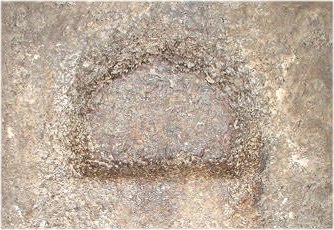
There is a stone protrusion on the north face of the first object that you come across in the antechamber: two large stone blocks which are fixed in place and are embedded into two vertical grooves which have been cut into the east and west walls of the chamber. The two stone blocks sit one on top of the other, and therefore they have a horizontal joint between them which is shown on the drawing. On the face of the upper block is the protrusion which is shown in the photograph below and is also marked off on the interactive drawing.

So far in the architecture of the pyramid only two of the rotation angles of the Earth have been applied to the system, and this has been shown in the data panel below the drawing where the third Z-axis rotation has been permanently set at 0°. To understand what the stone protrusion is, you need to understand how the Z-axis rotation is applied to the Earth.
The X-axis rotation in the system is the axial tilt of the Earth, and the Y-axis rotation represents the position of the Earth in its annual orbit around the Sun, a value which astronomers call the 'true anomaly' of the planet. The Z-axis rotation is the rotation required to the Earth that is caused by the tilt of the Ecliptic to the Sun's equator and this is the value that was determined earlier in this work (page E6) from the Sun system when the gallery groove line was adjusted using the gallery end wall mathematics and also in the carving at the pyramid's entrance. It's value, set in stone, was 7.060543°.
The astronomy of the Z-axis rotation is shown in the illustration below, and can also be read up on this orbital elements page which carries a similar illustration and further explanation.

The Sun's equatorial plane is shown by a grid square drawn in perspective, and the Earth's orbital plane, the Ecliptic, is shown by the ellipse that is partially above the equatorial plane of the Sun and partially below. The section of the Ecliptic that is above the equatorial plane is slightly more than half of the ellipse because the Sun is not in the center of the ellipse but is situated at one of the two focii of the ellipse. The positioning of the focii is not to scale, but is to illustrate the underlying principal.
The protrusion on the stone in the antechamber is a carving of the section of the Ecliptic that is above the Sun's equatorial plane which you can see by comparing the illustration to the photograph.